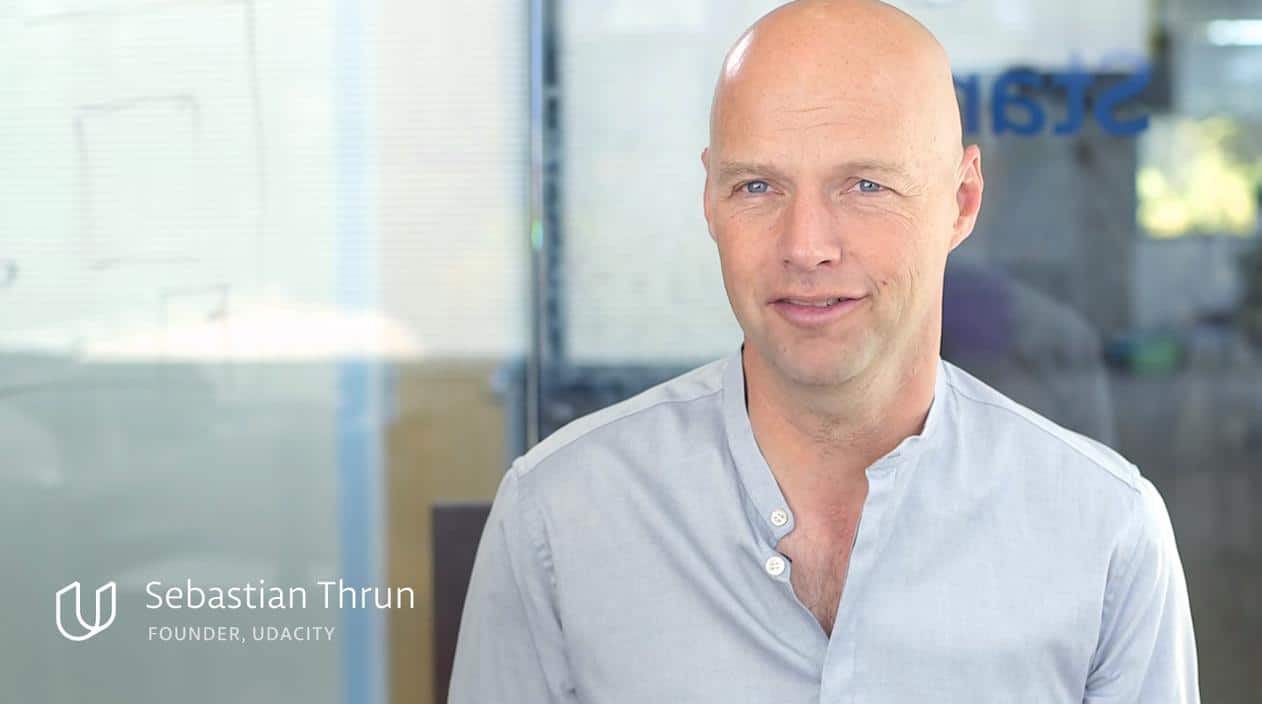Under Thrun, Udacity Revamps its Strategy
Thrun is trying to steer Udacity back on track to profitability by focusing, among others, on cutting costs, improving student support, and speeding up Nanodegree production.
From Excitement to Turmoil
After a successful funding round in 2015, Udacity’s valuation passed $1 billion, raising the company to unicorn status — a status that carries high expectations for growth.
These expectations were largely met over the next couple of years. Between 2016 and 2017, Udacity registered important year-over-year increases in key metrics:
| 2016 | 2017 | Change | |
| Annual Revenue | 29 million | 70 million | +141% |
| Paid Students (mid-December) | 13 thousand | 53 thousand | +308% |
| Total Nanodegree Graduates | 3 thousand | 18 thousand | +500% |
Udacity’s Self-Driving Car Engineer Nanodegree greatly contributed to this success. Launched in late 2016, it attracted over 10 thousand students in 2017.
But in 2018, numbers weren’t as positive. Many students graduated, but paid enrollments in December were down, and revenue increase was lackluster compared to the previous year:
| 2017 | 2018 | Change | |
| Annual Revenue | 70 million | 90 million | +29% |
| Paid Students (mid-December) | 53 thousand | 50 thousand | -6% |
| Total Nanodegree Graduates | 18 thousand | 65 thousand | +261% |
So overall, Udacity continued to grow, but at a pace that perhaps fell short of expectations.
Price increases likely played a role in enrollments drop. In 2018, the price of many Nanodegrees doubled. Some even tripled.
And pay cuts to Udacity Mentors, who are in charge of assisting students through their Nanodegree, surely weakened student support. Having completed three Nanodegrees in 2018, I can (anecdotally) attest to this.
In a clear sign of turmoil, Udacity laid off 25 employees in August 2018 — that is, about 5% of their workforce. But the cost-cutting measure may not have sufficed, because two months later, Vishal Makhijani stepped down as CEO of Udacity.
Trying to Right the Ship
Following Makhijani departure, Sebastian Thrun, Udacity co-founder and former CEO, retook the reins of the company on an interim basis. And more recently, Lalit Singh, former VP at Hewlett Packard Enterprise, joined Thrun as new interim COO.
According to TechCrunch, Thrun sent a high-spirited internal email in January 2019, calling on Udacity employees to persevere, be creative, and take risks. “I really wanted to wake up people to the fact that our trajectory was not long-term tenable,” he later explained.
Thrun is trying to steer Udacity back on track to profitability by focusing, among others, on cutting costs, improving student support, and speeding up Nanodegree production.
To attain those goals, Udacity has put in place a number of measures: they laid off 125 employees — that is, about a fourth of their workforce; they hired new Mentors and extended their role to include weekly video calls with students; and they adopted a leaner approach to course development, involving small but fast-moving content creation teams.
Will It Be Enough?
When Dhawal Shah, Class Central CEO, analyzed Udacity’s 2018 track record, he noted a distinct lack of major hits among Udacity’s new Nanodegrees — an assessment later confirmed by Thrun himself: “In 2018, we didn’t have a single blockbuster.”
By accelerating Nanodegree development, Thrun certainly hopes to shorten the time Udacity takes to find its next big hit. But Udacity now spends much less on Nanodegree production, which raises a question: can they both cut costs and maintain quality?
And if Mentor responsibilities increased, whether their pay increased accordingly isn’t clear. The new remuneration model relies heavily on bonuses tied to student retention rates. But can mentors realistically hit the metrics required to unlock those bonuses?
Under Thrun, Udacity is rapidly changing. But with rapid change comes significant uncertainty. As Thrun puts it, “the fruit remains to be seen.”








Andrew Kahr
The collapse of publishing on paper has drawn a bit of attention away from an equally-significant mega trend: It’s very hard to make money selling Internet content of any kind. Free competition and copying are just two of the reasons.
But there’s another, larger mega trend: we’re seeing that to get people to expend effort (work, study), they have to do it in physical proximity to each other. Remote working, flex time, distance education–none of that can fly for more than a handful. (Try adding “virtual reality:” it still won’t work.)
Give Udacity “credit” for serious, competent, multiple failed initiatives. Putting MS on line in partnership with universities; in-house corporate programs (reason for their failure is not one of those stated above–it’s different); fake degrees.
Too bad, Sebastian, but I doubt that Jasper will be able to do better. On the other hand, if women mistake you for Bezos…
Jim Massey
The Udacity content and platform was pretty decent, and aligned well with my learning style. I even bought in to a 2-part nanodegree program that started out pretty good…long enough for me to pass my refund period.
Then (in 2018) it all changed. The mentors weren’t available anymore (no 1:1), the communications platform became more ‘peer support’ and assignment grading added little/no value for me as a learner. (E.g. “Looks good” or “it works” aren’t helpful feedback for my assignments, nor are a bunch of pasted recommendations that I THINK I already demonstrated in my solutions.)
The result, for me, is that I did NOT finish the nano-degree (the second half anyway). The money was essentially flushed down the toilet and I consider it $1,000 contribution to my ‘lessons learned’ expense. Udacity was engaging and good, but there are too many alternatives, today, that deserve a chance at my money, more.